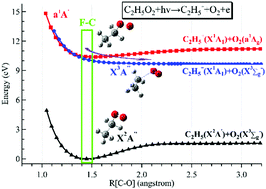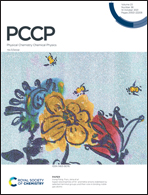Vacuum ultraviolet photochemistry of the conformers of the ethyl peroxy radical†
Abstract
We study the conformers of the ethyl peroxy radical (C2H5O2), the simplest peroxy radical having more than one conformer, by combining synchrotron radiation vacuum ultraviolet (VUV) photoionization mass spectrometry with theoretical calculations. The ethyl peroxy radical is formed in a microwave discharge flow tube through the reaction of the ethyl radical (C2H5) with oxygen molecules, where C2H5 is generated via the hydrogen-abstraction reaction of ethane with fluorine atoms. Two kinds of C2H5+, originating from photoionization of C2H5 and from dissociative photoionization of C2H5O2, whose cation is not stable, have been identified and separated in photoionization mass spectra. The photoionization spectrum corresponding to C2H5O2 is obtained and assigned with Franck–Condon calculations. The present findings show that the gauche conformer (G-C2H5O2) of C2H5O2 has favorable Franck–Condon factors in the ionization transitions, whereas the contribution of the trans conformer (T-C2H5O2) to the photoionization spectrum is minor or negligible due to its large geometric changes in the photoionization process. Moreover, the reason for the instability of C2H5O2+ and its detailed dissociation mechanisms have been unraveled with the aid of the calculated potential energy curves.

- This article is part of the themed collection: Festschrift Ivan Powis: Advances in Molecular Photoelectron Spectroscopy: Fundamentals & Application


 Please wait while we load your content...
Please wait while we load your content...